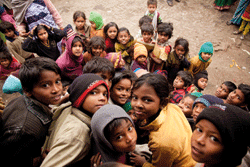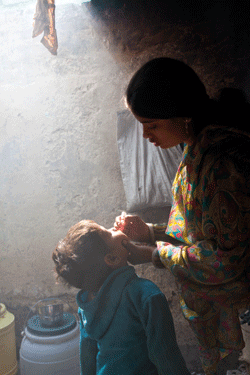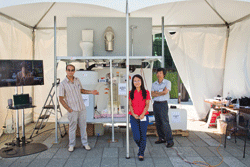
IP and Philanthropy: the Gates Foundation's approach
By Catherine Jewell, Communications Division, WIPO
The Bill & Melinda Gates Foundation is driven by the conviction that "every person deserves the chance to live a healthy and productive life." Since 1994, the Foundation has distributed some US$23 billion in grants and is supporting work in over 100 countries. In its push to maximize the impact of its activities, the Foundation lives by four core values - optimism, collaboration, rigor and innovation. "We believe in the power of innovation to solve problems," Bill Gates affirmed in his Dimbleby Lecture in London (UK) in January 2013. Together with its partners, the Foundation has developed over 100 innovations to help transform lives; some are already available and others are scheduled for delivery by the end of the decade. WIPO Magazine sat down with Richard Wilder, Associate Legal Counsel for the Foundation's Global Health Program, who explained the role that intellectual property (IP) plays in the Foundation's work.

Maximizing impact
The Foundation focuses on key areas that will have the greatest social impact. "Our Global Program targets a limited number of diseases and health conditions that account for a significant share of illness and death in developing countries," Mr. Wilder explained. "The Foundation works hard to harness advances in science and technology to address major causes of illness, primarily infectious diseases and neonatal and maternal healthcare, but vaccines remain our highest priority. Of all development spending, the best investment so far is vaccines," Mr. Wilder noted, pointing to the huge impact vaccines have had in reducing child mortality and morbidity rates. By 2025, the Foundation aims to have vaccinated 90 percent of children against diseases such as measles and rotavirus.
The power of partnership
Partnerships and collaborations are a critical element of the Foundation's strategy. "We believe in the power of partnership to expand the reach and depth of our work," Mr. Wilder explained. "We seek out collaborative partnerships with those that have the tools and infrastructure to do what is needed to bring about the changes that will enable all people to live healthy and productive lives. We cannot do it alone, our grantees and partners are at the center of our work. Partnerships enable us to draw on the unique talents, resources and know-how of industry, academia and the public sector to create affordable new health tools tailored to the needs of developing countries."
What role for intellectual property?
But what is the role of intellectual property (IP) in the Foundation's strategy? "Our use of IP is driven by the fact that we are results oriented. At the end of all the work we do, we want to see to it that a product comes into the markets we serve and is of benefit to the populations we serve," Mr. Wilder said. IP often plays a role in the Foundation's many partnerships and global collaborations in so far as it establishes from the outset who holds rights in a given technology and how that technology is to be used and deployed once developed. "With all the investments we make, IP is managed to achieve global access," Mr. Wilder noted.
For the Foundation, global access entails the prompt and broad dissemination of knowledge and information generated by funded projects and the availability of all products arising from such projects at affordable prices to those most in need in developing countries. "There are lots of detailed and closely negotiated agreements that have to be put in place, including IP licenses, confidentiality agreements, material transfer agreements, and the like - it's the basic tool kit that is used in lots of different settings," he said, noting the particular challenges arising from the philanthropic nature of the Foundation's work .
"Articulating the global access objective and embodying it in the legal text is something that requires a fair amount of explanation up front with companies and universities we are working with for the first time and often requires the negotiation of special terms to ensure we get what we need in terms of global access," Mr. Wilder said, explaining that IP agreements and global access commitments vary according to the funding option, nature and evolution of a project and the entities involved. "From the early days, it was clear that our partners wanted to see IP managed appropriately," he said. "In so far as we are talking about IP embodied in products, the people who own those IP rights are obviously going to be very sensitive and want to be sure that they are dealt with appropriately. They accept our global access principles and agree that, at the end of the day, the product will be accessible. But if there is a commercial advantage to be obtained by launching a technology in other markets or for other populations, they don't want to give that up and we don't want them to give it up because profitability in those other markets can make their work sustainable. "

Funding options
The Foundation's funding options include grants, contracts and program-related investments (PRIs). In 2011, the last year for which data is available, the Global Health Program disbursed almost US$2 billion in grants.
Grant funding normally involves the Foundation's IP team negotiating agreements to ensure that global access is unimpeded or to secure commitments relating to the specific quantity, pricing and delivery of a product, all of which takes place prior to the disbursement of grant money. However, management of IP arising from funded developments is generally left to grantees and partners once a commitment to global access is secured. When the Foundation enters into a contract for specific work to be done, it is usually in relation to a study or white paper and, as a general rule the Foundation owns the copyright in these materials. Where contracts entered into by the Foundation are more complex, however, there is a need to negotiate commensurately more complicated provisions around IP ownership and licensing. The overarching goal, however, is to ensure that global access is achieved.
The Foundation is also increasingly using PRIs - including equity investments in companies, normally small start-ups that may have been recently spun out of university research. In such investments, close attention is paid to IP rights and licensing to ensure that the technology owned and developed by such companies will be put to the service of achieving the Foundation's global access objectives.
The transformative power of innovation
In line with its belief in the transformative power of innovation, the Foundation is constantly pushing for new solutions to improve global health, and alleviate hunger and poverty in the developing world. "We begin by defining a technical solution we want to achieve, whether it be re-inventing the toilet or developing a vaccine for HIV/AIDS or a needle-free injection system then we request proposals from the relevant public so that we get the widest possible input from people with solutions to solve those problems," Mr. Wilder explained.
Grand Challenges Explorations
In 2008, the Foundation launched the first round of its Grand Challenges Explorations (GCE), a US$100 million initiative to foster collaborative research and innovation to improve global health and development. Initial awards are US$100,000 but projects demonstrating potential may receive additional funding of up to US$1 million. "This is a standard approach," Mr. Wilder noted.
"Thanks to these initiatives we have been able to make good progress in overcoming some of the technical hurdles associated with developing new drugs and vaccines, for example. We work with grantees to ensure they have the relevant IP rights for the development, use, manufacture, marketing, commercialization and distribution of funded developments to ensure global access." The GCE program targets established researchers in science and technology and also reaches out to young entrepreneurs and innovators to help expand the pipeline of ideas to tackle tough social challenges. "Part of the reason for doing this is to reach a broader range of actors than is the case with the larger grants. It is proving to be quite successful," he said.
Each round of the GCE program identifies areas for which creative new ideas and solutions are required and invites proposals. For example, the Foundation recently requested proposals for next-generation sanitation technologies to help reduce diarrheal disease. Many communities in the developing world do not have access to electricity or running water and are unable to run adequate sanitation facilities. "We need a technology that works off the grid," Mr. Wilder said. "The GCE program has generated some really interesting ideas and we are going to be funding some of them for future development, making sure that they are affordable and accessible to poor people in poor countries. "
"These new technologies will very likely be covered by IP rights because there is a commercial market for such toilets on pleasure craft, ships, rural camps and the like. Grantees are perfectly free to serve these commercial markets (or license others to do so) to become profitable and sustainable, but we want to be sure that the products we invest in are available and affordable in the markets we are targeting," he added.
The Foundation's commitment to innovation goes beyond the development of new technologies, and includes a strong emphasis on developing more effective ways to deliver these innovations to those most in need. "None of these innovations will make any difference if they don't reach the people we are targeting," noted Mr. Wilder. "You have to plan the roll out and uptake of new products. It doesn't happen by magic. To ensure that our work is part of a coherent whole we are adopting a more integrated and holistic approach, to drive end-to-end impact from discovery through to delivery," he said. "Part of this restructuring exercise involves establishing a new IP management system to better track global access commitments, licenses and relevant IP. "
The Foundation's strategic use of IP is enabling it to leverage its resources and harness the transformative power of innovation to tackle some of the world's toughest development challenges. Where the Foundation has succeeded, others in the philanthropic sector may well follow.
Re-inventing the toilet

Today, more than 2.6 billion people - some 40 percent of the world's population - lack access to basic sanitation services. In 2011, the Gates Foundation challenged researchers and innovators to re-invent the toilet, a utility that has evolved little since it was first invented in 1775.
Universities were invited to design toilets that can capture and process human waste off the grid and transform it into useful resources, such as energy and water at a cost of no more than US$0.05 per person per day including capital, operational and maintenance costs.
Researchers at the California Institute of Technology (US) (pictured on the left) won first prize with their solar-powered toilet that generates hydrogen and electricity.
At an event showcasing the winning entries, the Foundation's co-chair, Bill Gates said, "Innovative solutions change people's lives for the better. If we apply creative thinking to every challenge, such as dealing with human waste, we can fix some of the world's toughest problems."
The WIPO Magazine is intended to help broaden public understanding of intellectual property and of WIPO’s work, and is not an official document of WIPO. The designations employed and the presentation of material throughout this publication do not imply the expression of any opinion whatsoever on the part of WIPO concerning the legal status of any country, territory or area or of its authorities, or concerning the delimitation of its frontiers or boundaries. This publication is not intended to reflect the views of the Member States or the WIPO Secretariat. The mention of specific companies or products of manufacturers does not imply that they are endorsed or recommended by WIPO in preference to others of a similar nature that are not mentioned.